Description
Genus: Neoboletus
- Genus 2: Suillellus
- Genus 3: Boletus
Species: subvelutipes (see Science Notes)
- Species 2: austrinus (This may be an independent southern species – it’s listed as such in online sources – but it doesn’t appear in North American Boletes and the best description I’ve found is “B. subvelutipes with purple hairs/tufts on the stem instead of yellow or red.” Expect “austrinus” to be revived as one of the species names for this group once a broad DNA study has been completed to tell us how many species there are. We are folding the names together until then.
Common Name: “Red Mouth Bolete”
Tells: Red/brown/orange pores instantly stain blue, as does the bright yellow flesh. Blue-staining red/yellow stem has no netting, and should have velvety hairs at the base.
Other Information: Found under hemlock and very occasionally with other conifers. The lookalike oak-lovers are genetically distinct. Flesh has sometimes been reported as tasting a bit acidic, but that is not a reliable characteristic and may actually indicate one of the as-yet-unnamed subspecies (see Science Notes). The hairs at the stem base (which look more like velvet than hairs) are also unreliable. Specimens showing the velvety hairs typically have a yellow fuzz when young, which quickly turns dark red.
Edibility: Your author finds the oak-loving lookalikes delicious, as did Gary Lincoff (who also liked these). Between us and many others they have now been eaten them regularly for the past several years, with no reported consequences. With that said, Scarletinas remain on the “Iffy” list rather than “Choice” because the traditional instruction in America was so clear: “Avoid the red-pored blue-stainers like this one unless you want to get sick.” That myth has now been destroyed, but we do not have the many decades of practical experience required to be 100% sure about things like individual sensitivities and whether my European sources are right about the need to cook them extra thoroughly. So I guess the bottom line would be this: “Choice, with cautions and maybe reservations.”
Science Notes: The species was originally described in 1889 by the legendary mycologist Charles Horton Peck. The velvety hairs at the base – which many modern foragers have despaired of finding – was actually the basis for Peck’s decision to declare it a species. Sub- = barely; velut- =velvety; and -pes = foot. After 1889 the description slowly morphed until it really came to mean, “That common red-pored, blue-staining, non-reticulated mushroom in the East.” In other words, genuine experts used such a broad brush that everyone knew the DNA revolution would show it to be a group of similar looking mushrooms that would need to be sorted out. And sure enough, the DNA testing has confirmed just that. Subvelutipes has finally – finally! – been limited to a single species through a search at the exact location where Peck found the holotype, combined with heroic DNA extraction techniques that confirmed the connection. The velvety foot and hemlock association are very important for a firm ID, subject to environmental factors that will often hide or destroy such a delicate feature.
The parallel, oak-loving red mouths appear in the books under a series European names such as discolor and luridiformis, along with poorly described American names like subluridellus. Unpublished DNA work suggests 4-5 separate species in that category that will ultimately require “holding names” until the scientific method plays out
Finally, there is an undescribed species found in the Southwest mountains that is either subvelutipes or a good lookalike. We are waiting for DNA results before expanding the published geographic range to include those finds.
- NH4OH (Ammonia): Cap skin turns mahogany-red. Blue-stained cap flesh turns rusty orange.
- KOH: Cap skin turns mahogany-red. Blue-stained cap flesh turns rusty orange.
- FeSO4 (Iron Salts): Cap skin turns grayish- to dark olive-green. Blue-stained cap flesh turns yellow orange.
Links:
 |
572 |  |
292 |  |
167 |  |
315 |

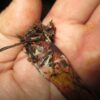
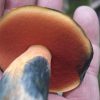
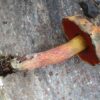
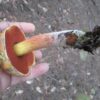
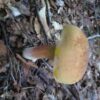
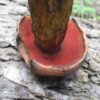
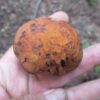
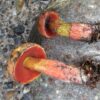
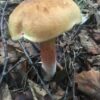
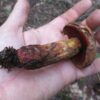
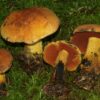
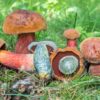
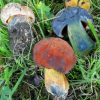
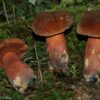
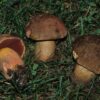
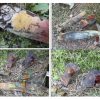
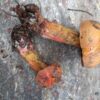
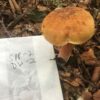
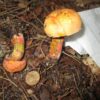
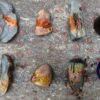
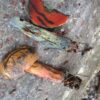
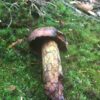
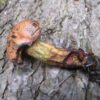
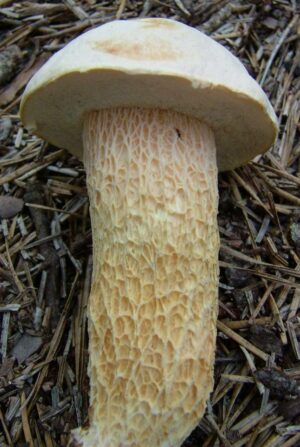
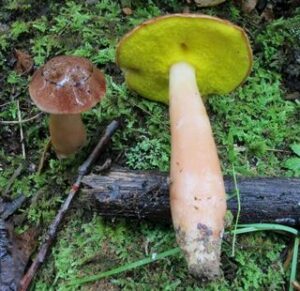
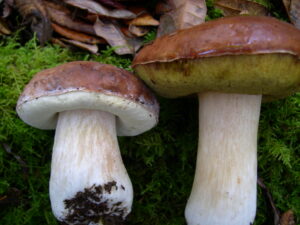
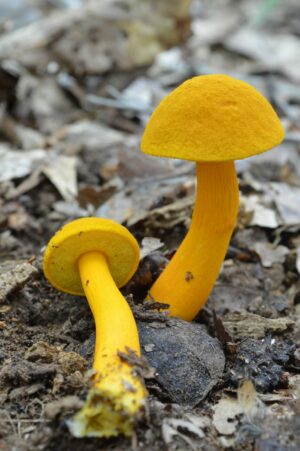
Got something to discuss?
Has anyone else noticed that this mushroom seems to feel colder in the hand than other boletes found at the same time and location?
Believe I found one of these in northern NM, Aug. 11, 2019, around 10,000 ft, near Engelmann spruce and meadows. Unfortunately did not save it; didn’t realize it was so rare. Have some decent photos that seem to show velvety hairs at base, and a nearly exact location.
I have actually been speaking with several experts from your area and the identity of your find is significantly up in the air. We do not know if it is the actual “subvelutipes” or rather a lookalike. I believe there is some DNA testing underway that will ultimately provide an up or down answer.
The key shows this bolete associated exclusively with conifers, but we are finding it in Green-Wood Cemetery here in Brooklyn under Fagus and Quercus. Michael Kuo also documents it under several hardwood species (https://www.mushroomexpert.com/boletus_subvelutipes.html)
The more recent work, about to be published, splits subvelutipes up into two lookalike species. The hemlock/conifer lover keeps the original name “subvelutipes.” The very common oak lover is a different species in the genus Neoboletus. We aren’t yet sure which species it will be. Maybe subluridellus? The oak lover is a great chameleon, so it’s very hard to be sure until DNA results get published. It’s still possible that the hemlock lover will grow with deciduous trees, and vice versa for the oak lover, but DNA testing has shown a pretty consistent adherence to that basic line. Igor Safonov, who has contributed a huge amount to this site, may be the best expert there is on this group. He’d be the one to contact for a deeper understanding.